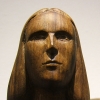A really good way to apply your wax...

| 06 November 2023 08:47
Christine - I wouldn't bother removing the first layer of beeswax, though the warming up will tend to merge the two.
How about doing some science experiments? Make up just a little beeswax with more carnauba and make a note of what you do. Test on a spare piece of wood and judge your results. You'll always have the 'recipes' for future reference.
Remember to burnish - rub - really well with a clean cloth for the best shine but do let the wax dry first.

| 05 November 2023 12:34
Good morning!
1st, I applied teak oil I had laying around as my first layer. (To be honest, I’m not thrilled with the “orangey” color) But it darkened the wood which brought out the depth I think
The next day I applied the paste I made from beeswax, carnauba wax and turpentine. I used the blow-dry method.
Maybe I should have waited a few more days before applying the wax paste? Or, perhaps my measurements were a bit off with waxes and turpentine? I could make a fresh batch today. But then I suppose I would need to remove the 1st layer of wax?

| 05 November 2023 09:34
Christine - You can make the beeswax shinier by adding a little carnauba wax. You'll need to experiment but less that 5% is usually enough. You'll have to search online.)
Carnauba wax dried very hard, and thus shiny. It's used to coat chocolates, among other things, say, so they don't melt in your hand...

| 04 November 2023 21:21
Hi Chris - I just finished applying my wax. It is definitely matte, not the shine I was hoping for, but I am very pleased none the less. thank you so much for the many great things I get to learn here.

| 18 December 2016 09:39
Karen - First thing: If you are unsure about the effects of a finish, it's very good advice test it on an offcut, similar surfacet and same species of wood, before using it on your carving...
My experience is that oils will bring out the figuring in the surface more, and darken it. So perfect for the sort of wood in the picture above. I ever use oils on light wood such as Bass or our Limewood, which is the same species. These I would wax.
I will seal the wood first with a UV resistant acrylic varnish (from art suppliers - I don't know the 3M product) where I'm trying to keep the colour; in Yew wood for example, but mostly I just go for the wax.
The pores of an absorbent wood will readily seal up with the wax, though you may need a second coat. With oil or stains, the absorbent parts (end grain) will soak up more and darken, so the finish is quite uneven.
So, what's my advice her, besides the testing? Seal and wax. No oil.

| 16 December 2016 15:02
Chris I have found all of these comments very interesting, but, I'm thinking of waxing a small carving of an angel, carved in basswood. (Christmas present!) Basswood being more of an absorbent wood would you spray it with say a 3M product for artists then wax it? I would like to keep the colour light. Is it necessary to oil it first like some have suggested here?

| 15 February 2016 14:05
Chris, I use almost the same method, but with a heat gun. I also use a 'white' cloth because of the turpentine which can rub off the color of the cloth in the wood!

| 14 May 2015 19:01
I already have made many experiments on it. Made some with beeswax and olive oil, some with teak oil added (love the smell) and some with dark beeswax. No major differences only dark beeswax made it darker. Afterwards i added carnauba wax to the mix. No matter how much i added it didnt give me any shine, sadly. All those were done on american walnut ( light greyish brown color), none of the results satisfied me. So i stained the wood with nescaffe melted in water (my crazy idea), let it dry and put a coat of wax on it. I like the results but still not very happy with it. I want a little natural shine.

| 12 May 2015 06:19
Laurent - That's a new one on me! When you add turpentine to beeswax to make it thinner (and usable), you are not oiling the wood, just waxing it. Linseed oil seems to react with the wood, making it darker and bringing out more of the figuring but I don't know if there is the same effect with olive oil. I can readily understand about the smell however; linseed is a bit strong and takes a while to go - one reason why I oil first then wax over. So, do you want oil in the wood or not? If so, olive oil with the wax sounds like an interesting experiment. Let us know how you get on!

| 10 May 2015 17:08
Hi chris, i have learnt a new recipe for beeswax preperation. It uses olive oil instead of turpentine which means less smells and adds oil to the wood. I am wonderring if there's going to be any difference on the long run or anything at all?

| 05 January 2015 15:07
Dermot - The main thing I'd say is that the carving wants to be clean. A grubby surface, pencil marks etc - all these will be sealed in and remain, and that's not the same as a genuine patina that comes with age and handling. Other than that, straight on to bare wood. You can wax over an oiled surface, by the way, and a lot of 'antique' or 'restorative' waxes will have a little linseed oil mixed in with them. These work best on richer, deeper coloured woods.

| 04 January 2015 11:29
Chris, what preparation to the carving is needed before applying the beeswax?

| 18 March 2014 16:05
Linda Smothers
I just finished waxing a cherry wood love spoon and it has turned out beautiful. I am so proud of it. Thank you Chris for sharing your knowledge.

| 17 March 2014 19:35
Raul - My guess is that the beeswax hasn't gone hard yet. The turpentine in the polish takes a while to evaporate and until it does the wax will be soft and not reflect light. The wax must be hard to be shiny. So I'd leave it a while than rub with a clean cloth or brush and see if the shine appears.

| 17 March 2014 16:56
Hi Chris. I applied beeswax as your video. I do not understand ... I have completed and beeswax does not shine. Something must be done?

| 24 March 2012 14:49
Wow! Love all the videos regarding the wax. Never thought about using the hair dryer before - can't wait to try it...thank you!

| 08 November 2011 16:39
Having been woodworker (turner, etc) I have all stuff needed. What is new to me is the formula which will help BUT wonder if you have ever tried Microcrystaline wax?
I really like its working properties and also the fact that it doesn't show any damage due to people handling the object. A real plus that is, no finger print probolem, but it is not for the frugal folks.
When one considers if used properly it really isn't that expensive per project as a little dab is do ya! Remember Brill Cream... Just have to get over that initial outlay for such a little looking jar.
Don

| 13 June 2011 06:52
Hi Chris,
Thats excellent! I've got an old lump of bees wax that somebody gave to me. Can't wait to get the rest of the stuff together and have a go.